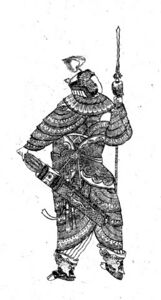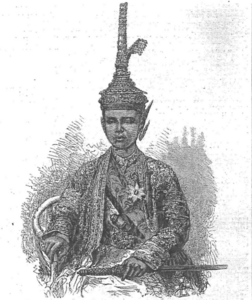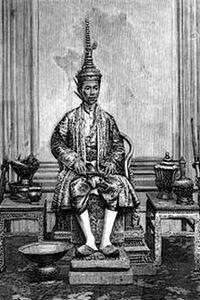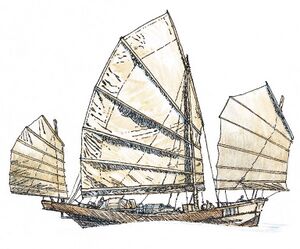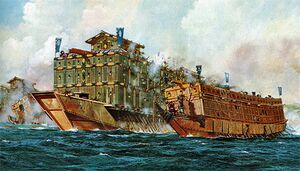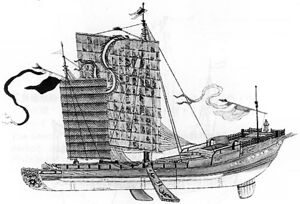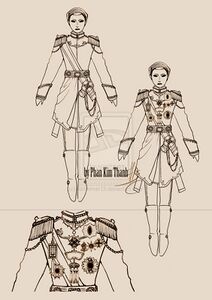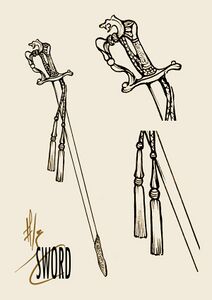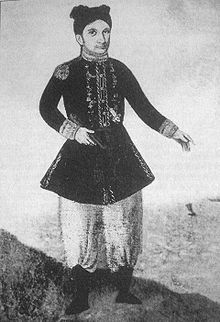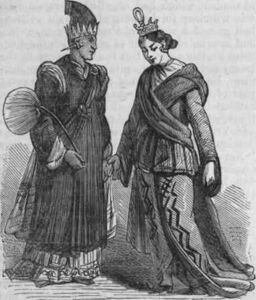Isles of Sinval
Located to the east of the continent of Auros lay the rocky islands of Sinval (also known as Si’nevaal, Sinvayal), home to the proud Sinvali and their towering ships. The Sinvali are a seafaring people by tradition and need as the islands are not suited to support the entire population through agriculture. Renowned throughout the world as sea nomads, merchants, sailors and fishermen, one is bound to find a fellow Sinvali at any of the major ports or on ships as captains and navigators.
Today Sinval is a melting pot of many cultures imported by returning countrymen and foreign descendants. Recently, there is a growing movement to restore old traditions to mainstream society, creating radicals who despise foreigners and certain half-castes, which is ironically against traditional Sinvali beliefs of openness and understanding.
Government[edit | edit source]
Nobility[edit | edit source]
Clergy[edit | edit source]
Military[edit | edit source]
Military might is not emphasised, throughout Sinval’s history it has never possessed an efficient centralised military. Most soldiers are in service to the Vandai as personal retainers and marines on sea vessels. The only standing forces on Sinval are the Protectors, responsible for public order in Sundregn, the capital. At most they numbered merely five hundred. Sinvalis are not known as great warriors; however the weapons that they prefer are axes, sabres and spears. Sinvalis wear lamellar armour or scale as a standard.
Religion[edit | edit source]
According to old Sinvali religious writings and oral traditions, mankind was created when Khavarenah the Goddess of Fate (also referred to as the Goddess of Luck and Fortune) decided to split up the world in two to end the conflict between two sea spirits, Miaszurias who became the founder of mankind and Tiasurphias, the primordial sea spirit.
The conflict began when Miaszurias sought to reach the stars, the domain of Khavarenah. This sparked a debate with Tiasurphias the Keeper of the Sea. Miaszurias attempted to break through the barrier that separated the sea from the sky however Tiasurphias caught him and cast him back into the sea. Tiasurphias then imprisoned Miaszurias in the Depthless Prison. Dauntlessly and taking it as a challenge, Miaszurias swam to its ends; eventually reaching it (took literally forever). At the end stood Tiasurphias, the two then engaged in a heated debate that shook the entire sea itself. Tiasurphias forbade him on the grounds of adhering to the laws and traditions of the sea, “for none have dared to try.” Miaszurias replied saying that in order to be closer to Khavarenah sacrifices, risk and new frontiers must be taken. All the other spirits began taking sides, half and half.
Khavarenah herself came down upon them, distraught to see her children in such a calamity. She raised the sea creating land for those who wished to be closer to her. Miaszurias and the others rose above the sea, embracing the moonlight, a sky lit by the stars. However in return they lost their ability to swim and so created vessels, boats, to travel. Miazurias still was not content and still desired to be placed upon the stars with Khavarenah and attempted to build stairs to reach the sky. Wind destroyed all of his attempts but this did not faze him. For an eternity he laboured to build an indestructible tower to reach Khavarenah. His peers looked above in awe as he finished the final piece, ascending into the Sea of Stars. They asked him, “How Miaszurias? Such is impossible.” He simply replied, “Leave your shells for they do you no good.” And so they did, Miaszurias passed onto them his sprit which they embraced, thus mankind was created.
When it was found out, Tiasurphias furious and jealous that Miaszurias had achieved what he feared cursed mankind with heavy waves and a plight of monsters that lurked under the deep sea. Human ships began to break in the waves and they no longer could fish for food. Inspired by Miaszurias, mankind built larger and stronger ships, created legendary spears to slay the sea monsters. Eventually Tiasurphias came to a compromised, moved by their actions. Tiasurphias soften the waves and allowed man to take his fish in return they give back what they’ve taken through tribute.
Today many Sinvalis do not take the words literally but rather see it as a symbolic representation of human determination and nature. The Star Spiral in Sundregn is said to be the same one that Miaszurias used during his reach to the stars.
The Sinvali do not view death as an entirely negative event, funerals are rather unusual as it is much more a celebration than mourning. This is often a target criticism of by foreigners who believe it is absolutely disrespectful.
Sinvalis either prefer cremation and their ashes scattered into the sea, symbolising the tribute given to Tiasurphias and the return to the sea or the later some, especially more wealthy and powerful individuals are given elaborate sea burials.
Funerals are often overseen by Azure’mir, however it is not necessary and some prefer families merely seek for their blessing preferring to conduct the ritual by themselves. Constant chanting and musical performances are held throughout the funeral.
The first ritual in a typical funeral would be the Three Gates ritual which is simply a symbolic representation of Miaszurias’ journey. Three rings are placed in sequence. The deceased persons most valued object or symbol is then held by his or hers blood or adopted relatives. The selected person then passes through the three rings with the object in hand essentially leading them through the same path as Miaszurias reaching the stars.
The second ritual is the cremation of the body on an open pyre, traditionally during the night where the stars are clear in the sky. This represents the removal of the “shell” and spiritual ascendance into the Sea of Stars. A variant of it is a small raft is lit on fire and pushed into the ocean.
The third ritual is the reading of the Death Oath, which has been written most of the time by the deceased beforehand or by a loved one. It is a personal acceptance of death and said to inform the Goddess Khavarenah of their imminent arrival. The ashes are then scattered into the sea if they have not been already.
After the funeral is over, a huge celebration occurs to celebrate the deceased individual’s life. Expressing strong grief is seen as rude; though crying is generally accepted and seen as tears of joy. The celebrations continue until day break, when the stars are no longer visible signifying that the deceased has left this world for good and joined Miaszurias and their ancestors above.
As Sinvali culture has been influenced heavily by foreign cultures, the old ways may not be done at all, however most Sinvalis keep a certain element of it in their own funerals.
Ih'weseil’s death oath, “Khavarenah set me free, like she did, Miaszurias – I will soar higher say this son of chains, Lord of Nothing.”
History[edit | edit source]
According to legend, Sinval (also known as Sinvayal, Si’nevaal or Su’nvaal) was formed when a group of freed slaves from Ulyssa and Rune’daath mutinied against their slavers and took slave ships. Sailing around the southern tip of Auros and circling east, they accidentally discovered the Sinval Isles and encountered Ancient Sinvalis, who at first were cautious towards them. Eventually both parties came to mutual understanding – between Ih’weseil (real name unconfirmed, name in Common, Cyrus), leader of the slaves and Ahiasasus (name in Common, Matthias), High Chieftain of the tribes.
Ancient Sinvali spiritual beliefs are rooted in the stars, their knowledge of the celestial bodies were ahead of their time and allowed them to navigate the waters around the islands with ease and speed. Combined with knowledge, the slave ships (speculated to be the Ulyssian triremes) which were larger and more advanced than the Ancient Sinvali ships and were used to great effect in becoming notorious pirates.
Naturally the slaves were assimilated into the Sinvali tribes as they had no real identity of their own. The assimilation gave birth to modern day Sinval. There was eventually a shift in society towards trading as it was more profitable. Sinval is not rich in natural resources; the majority of its society is geared towards maritime pursuits, producing great sailors and fleets of ships. They were often hired by other nations to serve as transports, building up their reputation as reliable sailors. Eventually some Sinvali captains were wealthy enough to start their own company, ferrying goods between major ports making profit, giving way for the stereotypical image of the shrewd Sinvali merchant.
Before the arrival of the slaves Sinval was originally a loosely defined region with hundreds of different clans. It was Ahiasasus who unified the clans with the help of Ih’weseil and formed modern day Sinval. Three hundred years of dynastic rule ended when the Empire of Ulyssa invaded Sinval.
At the peak of Sinvali trade activity a war between the major clans occurred which set a precedent for the division of trade sectors and enforced peace between the clans. The war ended when the Azure’mir forced the clans to settle, dividing up the trade sectors. This action was believed to be a breach of the caste system causing many to break off from Sinval which explains why there are many overseas Sinvali who have assimilated into other cultures.
Nowadays, the population on Sinval itself is many times smaller than its overseas communities and descendants. Through time many Sinvalis, distant from their homeland, have adopted other cultures, Elten influences are strongly present in Sinval society which has been imported by returning captains and sailors. Many overseas Sinval do not consider themselves as full Sinvali but some hold strong connection to their ancestral homeland. Due to the destruction caused by the Ulyssa's invasion, Sinvali people across the world make arduous journeys enduring great hardships to rebuild their homeland, fulfilling one of the most important aspects in Sinvali culture, a sense of duty.
Archaeological and linguistic evidence suggests that Ancient Sinvalis were explorers from Nobugo several hundred years ago. This explains why the appearance of the Pure Sinvalis is similar to Nobugohito from particular nations. Linguistically certain aspects and words of Biyal (the language of Sinval) take strongly from the Nobugohito language. Rune’Daathian and Ulyssian influences are also present albeit less culturally and more linguistically.
Sinvalis have always been an oppressed people; the Isles have been occupied and transformed by many throughout its long history. Although technically under the Ulyssian Empire (as a colony) due to the distance and being politically neutral, the Sinvalis have virtually autonomous rule over the Isles with very little if at all Ulyssian interference.
Society[edit | edit source]
Sinvali society is a mix of ancient customs and the influences from foreign nations. Many have adopted Elten or Alenthylian names. Members of the high class often give themselves Traditional Biyal names to separate themselves from the lower class that no longer learn Traditional Biyal.
Before the invasion a distinct class of ruling nobles called Pharan held all the power in Sinval, however the power of the nobles have been in decline since the explosion of trade activities long ago. Families belonging to the Pharan caste either merged into the Vandai caste or became extinct.
Current Sinvali society is defined by a strict caste system. On the top of the pyramid is the Azure’mir, roughly translated to Sky Prince. They are the spiritual leaders of Sinval, educated from birth in the ways of Starseeking/gazing and Ancient Biyal. The world of the Azure’mir is secret even to the most powerful individuals on the Sinval Isles. Their role in society is to running the Sinval capital, Sundregn, and to maintain the Star Spiral, the holy site of the Sinvali people. There is no sole ruler. Rather it is speculated that among the Azure’mir, there is a chosen council that run the nation. Members are chosen at birth through a Sinvali ritual which determines whether they have been chosen by fate to join the Azure’mir in this case it is possible to classify the Azure’mir as a monastic order.
Below the Sky Princes are the Vandai, explorers and merchants. The Vandai hold the real power in Sinval as they are the holders of Sinval’s economic strength. They are divided up into many clans which are responsible for a different sector in the world. This is to avoid competition among the Vandai, although assassinations and underhand dealings are not uncommon. Due to its nature, clan members are numerous and within the major clans there are many cadet branches which vie for the position of Patriarch/Matriarch of the clan. The Vandai are also learned in the way of Stargazing as they are primarily captain of vessels or hired as navigators for foreign ships. The way that Stargazing utilised is much different than the Azure’mir, the Vandai use it for practical reasons while the former have spiritual uses. Among them, Biyal is rarely spoken and only used during traditional ceremonies or as a naming convention. Other than that they are no different from your typical merchant families which operate large trading companies.
The backbone of Sinvali society is the Astori, the commoners, made up of the skilled sailors, fishermen and craftsman. Many serve the Vandai on their ships or run their own business, either as fishermen with their own ships or craftsmen with a workshop. Family members often follow on the same path as their fathers or mothers leading to highly skilled artisans through generations of refinement. Astori are often seen overseas with their own workshops at major harbours around the world.
Foreigners and those who do not fit within the categories above are often taken under as Diakon, servants or apprentices which provides an opportunity for social mobility. Social discrimination is not a part of the Sinvali way; instead there is tension between the individuals that identify themselves as either Elten-Sinvali or Ulyssian-Sinvali and any other hybrid/half caste Sinvalis.
Despite having a strict caste system, social discrimination is rare, the interaction between people of higher and lower castes is a normal affair. It may be due to how rigidly defined each caste is and the cultural belief that all people enter the world and leave in the same manner. Moving up the caste system is possible through marriage or adoption – the higher caste takes precedent in determine which caste the child is born in. Only the Azure’mir caste is exempt from this as they are not allowed to raise children that are their own, rather the child is given up to be adopted by a fellow relative (the adopted child takes from their parent’s caste). It is not encouraged and slightly frowned upon for Azure’mir to have children.
Another aspect of Sinvali society is patronage. Esteemed individuals who belong to the Vandai are often seen funding and supporting the trades of the Astori caste. Patrons are well respected among the community as they are often the ones who start new ventures, opening up opportunities to people of all classes. Being greedy, i.e. hoarding wealth, is seen as distasteful, charity is a very important thing for the Sinvalis.
Important Aspects[edit | edit source]
Monocle[edit | edit source]
The most distinctive feature of any Sinvali dress would be the monocle. Contrary to common belief, the Sinvali monocle is not correctional like the ones worn in Elterlein. Instead it is a sort of portable sextant and compass which is the main instrument in Stargazing which allows its wearer to map out the stars visually. Prolonged wear will eventually cause colour blindness and damage the vision of the eye. In a way it is similar to the Volvarian Del'scar as it entails initiation and a sign of social status. The ritual of Stargazing is only available to those of the Azure’mir or Vandai castes. Both males and females are able to wear it, however, influenced by foreign sense of fashion; it is rare for a female to undergo the ritual.
Tied in with the Sinvali religion, the monocle is seen as a holy object and those that wield it are expected to adhere to very specific rules and certain regulations. The process of creating one is strenuous, a mixture of religious ritual and very fine jewellery and metalwork.
The lens of the monocle is first formed by infusing fine powdered arcane essence with the glass as it is being made, the process must be done at the right time and pace else the glass would shatter, it is not uncommon to have to retry several times to get lens to form properly. After the lens has been created, the individual who has taken the ritual then receives it where they spend several days in the Star Spiral meditating to gain Miaszurias’ spirit which is imbued into the lens of the monocle.
Afterwards, the lens must be aligned to the stars, to be focused. This step requires the individual to view through the lens, which results in the temporary loss of vision for a few hours. When vision is regained, they must choose the eye they would wear the monocle on.
The final step is the creation of the frame. The frame of the monocle represents the character of the Stargazer and is richly decorated with symbolism. Many styles of frame exist, the most common being the same one worn by Elten nationals and a rather distinct style would be the full head helmet mount style of monocle.
Stargazing[edit | edit source]
Ancient Sinvalis revered the stars, creating a way for them to commune with the stars at night. Essentially it is magical celestial navigation. This ability is achieved through magical instruments powered by the Arcane. At first the Ancient Sinvalis used a reflective sundial like object – this still had the effect of damaging the eyes however. Later on the Sinvalis created a telescope that provides the same function. Influences from Elterlein led to the monocle that is common today. The process is secret and is only known by selected Azure’mir.
Stargazing is believed to have been handed down by Miaszurias during his climb to the Sea of Stars. Although Stargazing is most effective at night, its abilities may still be used during the day although with less power. Although the Stargazers possess amazing navigational powers, maps are still used however to locate specific details and to understand the physical landscape. Stargazing does not work on other planes or worlds, only in the realm of mankind.
Stargazing abilities: • Pinpoint their position/location on the world. • Interpret the positioning of the stars at night, a spiritual ability. • Predict weather, natural phenomena. (not always accurate) • Keep track of their bearings.
Those who seek to be educated in Stargazing must go through the trials, eventually reaching the top of the Star Spiral. The trials follow the three stages in Miaszurias’ journey. Students are taught fundamental sea navigation skills and lots of magical theory behind Stargazing and put to a final trial of ascending the Star Spiral, here the students are expected to not only reach the top but also become spiritually enlightened.
Compass[edit | edit source]
Although made obsolete by Stargazing, it is still used by those without the ability and a symbolic representative of duty. Sinvalis are given compasses on their wedding day and before a long voyage as a good luck charm. Pocket compasses are a popular piece of accessory, especially worn as a necklace.
Another popular item in Sinvali culture would be the paired compass. According to legend, a mother gave her child one called “Moon” while she kept the “Sun”. The compasses always point to each other. One day her child was to be sent to fight Tiasurphias’ sea monsters, a fierce battle occurred and unfortunately her child did not return. The story usually continues to go on with the mother taking matters into her own hands and diving down into the Sea Realm and retrieving her child from the clutches of Tiasurphias and ends happily with them reunited again.
Ships[edit | edit source]
Before a ship sets on its maiden voyage it must be blessed by an Azure’mir. A custom strange to foreigners is the naming of the ships. Names must be ‘bad’ or absurd. According to superstition; names that are proud or pleasant are sunk for their insolence. Examples would be – The Leaky Cabbage, The Unforunate, The Beggars Pan, and Sink This Ship.
Sinvali ships are not designed for warfare, rather through generations of development they have been designed to be very large and seaworthy vessels. Sinvali ships are split into two categories, the Junk ship which is sailed powered and known throughout the world for their amazing speed while on the other hand are the Fortress Ships (which are reminiscent of the Ulyssian triremes) is an ancient design, pretty much floating castles and are primarily powered by oars rather than sails.
Sea Nomads[edit | edit source]
A unique aspect of Sinvali culture is the Askhopa, literally translated as drifters. Many Sinvalis opt to live on their boats which are transformed into a literal floating residence. Businesses are also run off the ships, serving passing ships. The ships could be anything from restaurants to full blown brothels.
Ashkopa often join up months at a time, chaining their ships together which move slowly across the sea. This serves two purposes, allows weary nomads to rest and recover and to cross dangerous waters infested with pirates or sea monsters. When ships are chained up they form a village like community with a population of around twenty to two hundred people at most.
Duelling[edit | edit source]
Another huge part of Sinvali culture is the ritualised duels, known as Szabala. A 'duel' usually starts when a challenger insults another person - often playfully/jokingly (however genuine distaste may incite one) in order to signify an offer to duel.
The receiver of the offer then replies in recognition, along the lines of "I demand satisfaction!"
At this point is it appropriate to begin the duel - with the crowd supporting both parties by shouting "Szabla!" or "Szabala!"
The participants then get into position ensuring that they are within range.
There is a set ritual that both parties must follow and do at the same time. - Point sabre towards each other’s chest, ensuring they touch. - Salute each other using the sabre and putting their non-dominant hand behind their back - Tap each other’s sword lightly - Raising the sword ready to go
The receiver of the challenge - in this case the insulted has the right of first strike and starts on their command.
After every successful hit - swords are lowered and the winning side is expected to offer peace "I am satisfied" and it is expected by the losing party to say "I am not satisfied." on the first strike.
In Szabala there are no winners or losers, both sides are congratulated equally after the bout.
In Sinvali culture, Szabala was popular among middle class and upper class men to solve minor disputes without chaotic violence and build comradeship between friends.
It has greater emphasis on personal development instead of physical strength.
By no means is Szabala designed to solve legal disputes, something most courts are more suited to solve - however in some circles Szabala has become so popular that it has become ingrained in everyday life for gentlemen and it was acceptable to solve major disputes through such means.
Honour is an integral part in Szabala - there is less honour in winning than in not backing down from a challenge from someone else. What is truly interesting and not seen in other cultures is that it is hugely egalitarian, it is not unusual to see a prominent noble in a Szabala with a common man. There is a great humbling factor as the nature of Szabala removes much of the factors involved in a real fight allowing luck and endurance to determine the outcomes. Literally anyone can challenge anyone, regardless of whether they know them or not. Though it does not mean that there is a lack of respect towards privacy - duels often occur in public spaces such as taverns or halls outside these places duels are arranged only.
Szabala is spontaneous by nature; a quiet night at the tavern may suddenly turn into something closer to wild party. Drunken duels often occur - the only time a fatality or unwanted wound may happen. Any out of control duels are stopped quickly by the Protectors.
Recent influences have caused the appeal of Szabala to go down; nowadays it’s quite rare to see Szabala in action publically. However it is still very popular among the Vandai caste due to the nature of the duel which many take advantage of in order to prove themselves among the clans.
Quirks[edit | edit source]
Overview[edit | edit source]
The idea of adopted family is a large part of Sinvali culture. Many consider their made-siblings more than or as important as their blood relatives. Sailing is often filled with loneliness and the time spent between sailors creates a sense of brotherhood which gave rise to the tradition of calling another as your brother or sister. There are many instances of where a father has died leaving behind several children, it would be expected that his blood brother would take care of them as he would his own children. Adoption is also very common which also acts as a method of social mobility.
Women in Sinval are treated equally as men; there are many women who are sailors and even Azure’mir, however they suffer discrimination while overseas meaning that most of the women work with Sinvali owned companies. This also applies to overseas Sinvali who have assimilated into other cultures.
It’s almost impossible to notice a mixed Sinvali by appearance alone. As mentioned before many overseas do not consider themselves as Sinvali but rather identify themselves where they were born and raised.
Appearance[edit | edit source]
Sinvalis are often of dark skin tones and have black/brown hair with grey or brown eyes.
Naming Conventions / Language[edit | edit source]
Biyal can be broken into two different categories – Traditional & Contemporary. Traditional Biyal is known for having a distinct hiss, especially when pronouncing si, su, and sus and possess strong Rune’Daathian and Nobugohito influences. Traditional Biyal is rarely spoken in everyday conversation and reserved only for “true naming” and religiously significant documents and rituals. Contemporary Biyal is the official language of Sinval. Through influences from other cultures have blended into something closely resembling Common in structure and is much easier to write and learn.
The true naming ritual is of significance to the Vandai class as it symbolised the eternal link between the person and Sinval. It’s also represents the character of the Sinvali people, adaptability and dutifulness. The name given is in Traditional often drawing from characters from mythology or famous ancient figures. However recently due to the popularity of common names, many consider their Contemporary name as their true name also if they’ve not been given one in Traditional.
Sinvalis draw their last name from their clan and their middle name from one of their parents mostly the parent of the same gender is chosen as the middle name, example Ossil Fleis vaa’Viashursias, vaa meaning born “of”, or “of”. Example of a Contemporary name – Makara Daleshmey Rangsei, unlike Traditional Biyal naming which emphasises clan/family links; families from the lower class follow the following convention.
Middle names can be anything from a name of a significant ancestor or your other parent’s family name. However it is not to say that there are specific cultural rules on naming other than a trend, (Family Name) (Given Name) is also quite common, for the sake of convenience (First Name) (Last Name) is used in almost all cases.
A traveller once noticed the same group of Sinvali merchants he met before had completely different names from the last time. Sinvalis often change their “cover name” every time they travel to a new destination in order to fit in and symbolise the progress and length of their travels. A Sinvali who travels to Nobugo for example would take up a name that is familiar sounding or exact of that culture’s language. These situations show were true names come into play, as the true name symbolises their link to Sinval, among family and very close friends, their true name is used among them during their journey.
Traditional Sinvali saying: “A thousand names one may hold, yet remember the one bestowed upon the night, the brightest star.”
Examples of names -
Traditional names: Ahiasasus, Ar'khaushal, Fesil’vsih, Ihwe’seil
Reallife equivalents and inspiration: Persian/Arabic & Egyptian
Contemporary: Daleshmay, Rangsei, Sotharith, Vizan/Visan, Makara, Maelis
Real life equivalents & inspiration: Khmer/Cambodian, Thai, Lao and Vietnamese names (anything South East Asian)
Practices[edit | edit source]
Clothing[edit | edit source]
Elten-inspired fashion has taken the stage as mainstream wear, however certain aspects of Sinvali fashion is infused with it. Sinvalis prefer bright colours, especially a vibrant red colour. Patriarchs of the Vandai caste are often seen in portraits wearing an elaborate helmet called an Azuril, which is clearly inspired by the Star Spiral.
Women are often wear colourful and highly detailed dresses that are usually made of silk with a greater Nobugohito influence than Elten. Short hair is preferred, often knotted or tied into a bun.
Traditional Sinvali hairstyles are often short, spiky or bald. However rat-tails or queue are popular among Sinvali males with the queue seen as a symbol of the Sinvali sailor made popular by the infamous pirate, Dheis Diari, self-proclaimed King of Pirates. Headwraps and or straw hat are often worn to protect against weather.
Food[edit | edit source]
Staples such as bread, corn and rice were introduced to Sinval via extensive trade. Traditional Sinvali cuisine includes: Seafood (especially sea snails and fish), berries and potatoes. The most famous Sinvali dish has to be the Silver Perch fish steamed, drizzled with fish sauce, topped with berries and usually eaten with rice. Fish sauce is used extensively in Sinvali Cuisine, which is made by fermenting small dried fish. Foreigners often comment on its pungent smell, remarking that it could kill.
Eating is done usually by hand however due to foreign influences dining utensils are widely used. Feasts are a large part of Sinvali culture; prominent families often hold a feast every month, inviting literally everyone. They say to be hungry in Sinval is a crime akin to committing murder, hospitality is very important in Sinval, guests are treated with utmost respect.
It is evident that Sinvalis rely on the local seas for their food, overfishing has become a problem over the times, prompting harsh restrictions to be enforced. Luckily with connections all over the world, the Sinvali have access to foods all around the world through the Vandai’s doing.
Marriage[edit | edit source]
Customs vary among the castes. Typically the Vandai place greater importance on hereditary rights and bonds making weddings a very serious event most likely politically or financially motivated while the Astori who do not emphasise hereditary rights hold more casual weddings.
After a couple and their families have consented to marriage an ancestral altar is set up either in the bride or grooms home or a site of religious/spiritual significance. The families involved pray for a total of three days and give offerings. The reason behind this is to give time for both of the families to prepare for a wedding (as it is rude and seen as impatience if prepared any earlier) and symbolises the act of asking for permission from their ancestors to accept the joining between their families.
On the day of the wedding ceremony, both families and close friends bring gifts and place them upon the ancestral altar. After the last prayer (to the ancestors) the wedding is the usual.
Same sex relationships are generally frowned upon in mainstream society since the emphasis on family is so important in Sinvali culture. Many see that same sex relationships do not contribute to the family overall. However it is not unheard of for married individuals to have same sex relationships, this is less frowned upon as they’ve “done their part” in continuing the family line. Same sex relationships are seen as acceptable among ship crews, for obvious reasons.
During an exchange of gifts, the giving of the compass, “Just remember to keep your compasses at home if you’re going to do something undutiful.” *sly smirk*
Slavery[edit | edit source]
Slavery is frowned upon and forbidden in Sinvali culture, however there are always exceptions and Sinvali slavers do exist, motivated purely by financial gain. In the same light, necromancy and any form of tampering with the dead is frowned upon.
Education[edit | edit source]
Magic[edit | edit source]
Funerals[edit | edit source]
Music[edit | edit source]
Traditional Sinvali music has its origins in the old religious music, utilising stringed instruments and wind instruments. It is still played today during religious celebrations and in certain Azure’mir rituals.
Sea shanties and everyday songs are widely popular among the Sinvalis as a majority of them are sailors or have been out at sea. Singing is a communal thing and is done by everyone during family gatherings and in public. It’s not uncommon at all to see a bunch of strangers joining together to sing a familiar tune during festivals and merry days.
